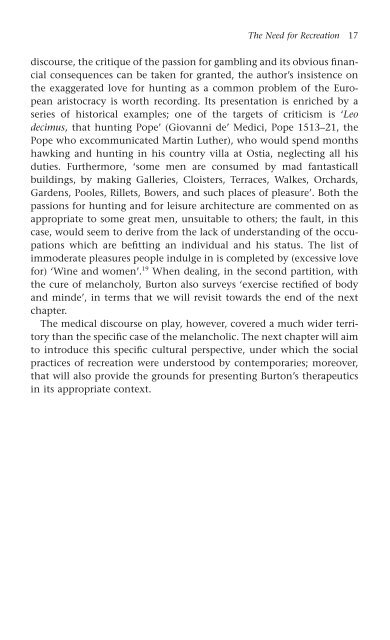Recreation in the Renaissance
Recreation in the Renaissance
Recreation in the Renaissance
- No tags were found...
Create successful ePaper yourself
Turn your PDF publications into a flip-book with our unique Google optimized e-Paper software.
The Need for <strong>Recreation</strong> 17<br />
discourse, <strong>the</strong> critique of <strong>the</strong> passion for gambl<strong>in</strong>g and its obvious f<strong>in</strong>ancial<br />
consequences can be taken for granted, <strong>the</strong> author’s <strong>in</strong>sistence on<br />
<strong>the</strong> exaggerated love for hunt<strong>in</strong>g as a common problem of <strong>the</strong> European<br />
aristocracy is worth record<strong>in</strong>g. Its presentation is enriched by a<br />
series of historical examples; one of <strong>the</strong> targets of criticism is ‘Leo<br />
decimus, that hunt<strong>in</strong>g Pope’ (Giovanni de’ Medici, Pope 1513–21, <strong>the</strong><br />
Pope who excommunicated Mart<strong>in</strong> Lu<strong>the</strong>r), who would spend months<br />
hawk<strong>in</strong>g and hunt<strong>in</strong>g <strong>in</strong> his country villa at Ostia, neglect<strong>in</strong>g all his<br />
duties. Fur<strong>the</strong>rmore, ‘some men are consumed by mad fantasticall<br />
build<strong>in</strong>gs, by mak<strong>in</strong>g Galleries, Cloisters, Terraces, Walkes, Orchards,<br />
Gardens, Pooles, Rillets, Bowers, and such places of pleasure’. Both <strong>the</strong><br />
passions for hunt<strong>in</strong>g and for leisure architecture are commented on as<br />
appropriate to some great men, unsuitable to o<strong>the</strong>rs; <strong>the</strong> fault, <strong>in</strong> this<br />
case, would seem to derive from <strong>the</strong> lack of understand<strong>in</strong>g of <strong>the</strong> occupations<br />
which are befitt<strong>in</strong>g an <strong>in</strong>dividual and his status. The list of<br />
immoderate pleasures people <strong>in</strong>dulge <strong>in</strong> is completed by (excessive love<br />
for) ‘W<strong>in</strong>e and women’. 19 When deal<strong>in</strong>g, <strong>in</strong> <strong>the</strong> second partition, with<br />
<strong>the</strong> cure of melancholy, Burton also surveys ‘exercise rectified of body<br />
and m<strong>in</strong>de’, <strong>in</strong> terms that we will revisit towards <strong>the</strong> end of <strong>the</strong> next<br />
chapter.<br />
The medical discourse on play, however, covered a much wider territory<br />
than <strong>the</strong> specific case of <strong>the</strong> melancholic. The next chapter will aim<br />
to <strong>in</strong>troduce this specific cultural perspective, under which <strong>the</strong> social<br />
practices of recreation were understood by contemporaries; moreover,<br />
that will also provide <strong>the</strong> grounds for present<strong>in</strong>g Burton’s <strong>the</strong>rapeutics<br />
<strong>in</strong> its appropriate context.










